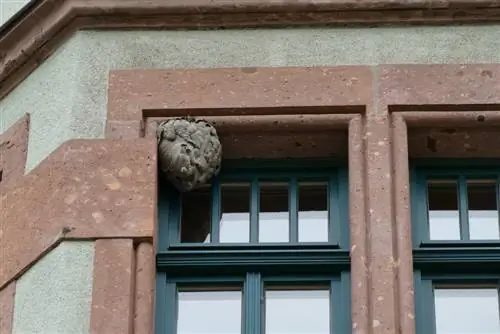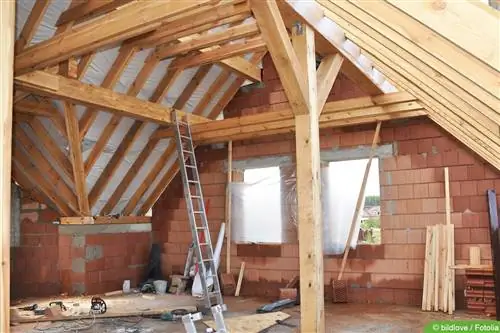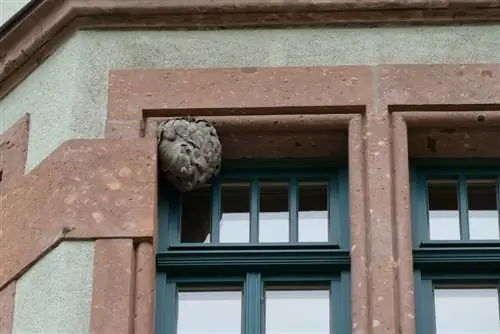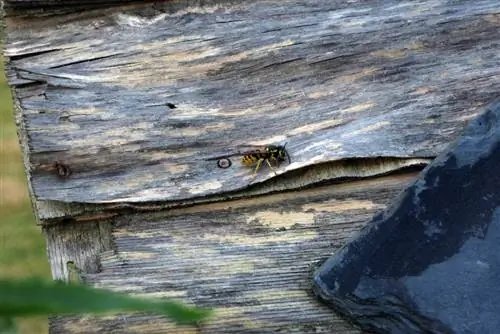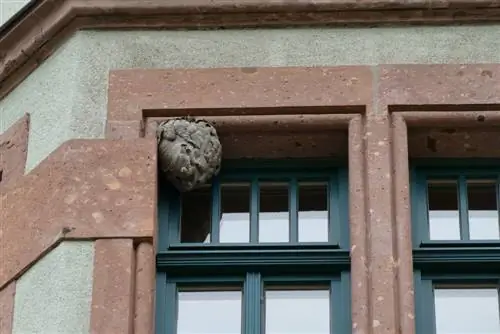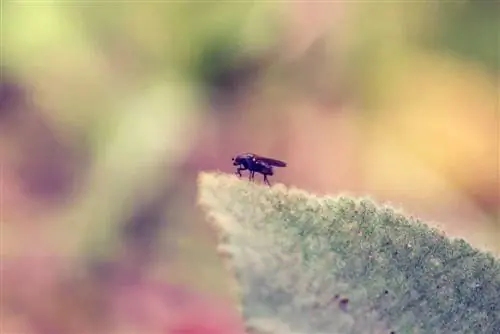- Author admin [email protected].
- Public 2023-12-17 03:39.
- Last modified 2025-06-01 06:48.
A wasp's nest under the roof initially triggers a small moment of shock for many homeowners. Ignorance and fear of these animals often cause panic, but in most cases this is unfounded. However, caution is advised, especially when children and allergy sufferers are affected. Wasps are not generally aggressive animals; they only sting to defend themselves. If the attic is only used as storage space, there is no danger. Otherwise, there are a few things that you should definitely pay attention to in order to avoid dangerous situations.
Attic ideal for nest building
Attics are often warm, dry and dark, protected from wind, weather and predators such as birds and therefore ideal for building nests. Wasps that increasingly fly towards the roof but also noticeably buzz and buzz around can be an indication that they have nested under the roof. A nest is usually only noticeable when it has already reached a considerable size. In spring it is usually still relatively small and inconspicuous.
By summer, the colony has grown to several thousand members, depending on the wasp species, and the wasp colony is complete. Now, especially the German wasp and the common wasp, they are increasingly turning to human food, which is sweet and sticky. Eliminating a nest at this time would be life-threatening. If the area in which the nest is located is only used sporadically, it is certainly advisable not to fight the animals and rather wait until late autumn or winter, then the old queen dies and the colony disperses.
Types of wasps that settle under the roof
The common wasp and German wasp are particularly disturbing because they prefer to eat sugary food. Both build their nests in dark cavities such as abandoned mole and mouse dwellings, but also in roller shutter boxes or in attics. The Saxon wasp also uses the roof beams of uninsulated attics, skylights and the like to build nests. It is one of the lesser-known wasp species and is also known as the 'attic wasp'.
- Life cycle of common and German wasps lasts from April/May to October
- The nests of the German wasp are gray and do not hang freely
- In extreme cases they can reach a circumference of up to 200 cm
- They are home to between 1000 and 10,000 animals
- The nest of the common wasp is beige to light brown and also not freely hanging
- It is populated by 500 - 7000 animals
- The Saxon wasp has a shorter life cycle
- It is active from around the end of May to the beginning of August
- Their nest is grey, heart-shaped, freely hanging and about the size of a football
- It is populated by 100 - 300 animals
In contrast to the German wasp and the common wasp, the Saxon wasp disdains sweet foods. She is very peaceful and only defends her nest in the immediate nest area.
Attics usually difficult terrain
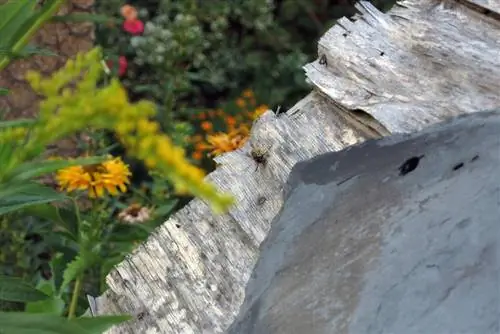
Attics are often difficult to access because everyday objects, furniture and much more are often stored here. In addition, the nests are usually at heights that cannot be reached without a ladder or other aids. It is therefore difficult to reach the nests in order to get rid of them or to drive the animals away using appropriate means. Anyone who is thinking about getting rid of the nest should ensure free access, eliminate tripping hazards and thus exclude additional sources of danger.
Have the wasp nest removed by a professional
If the wasp nest poses a concrete threat to the residents or severely limits the quality of life of the residents, there is usually no way around removing it. This is especially the case if small children or people with allergies are regularly near the nest. An inhabited nest in the skylight, under the roof tile or in hidden places under the roof should always be removed by a specialist. This can cost between 50 and 150 euros. Only these people have the necessary knowledge and the right equipment, including protective clothing, to eliminate the wasp nest safely and safely.
The professional removes the nest completely and moves it to another location. However, relocation requires approval and is only possible if a valid reason is presented. After the specialist has removed the nest, he removes all traces. This is necessary because the probability that the new queens will settle near the old nest again is very high because they are guided by its scent. The old nest is no longer used and remains empty. You can find out who is qualified to remove wasp nests from the relevant municipal or city administration. As a rule, these are pest controllers, beekeepers and sometimes also the local fire department or the nature conservation authority.
First aid until removal by a professional
Measures until the professional arrives are particularly necessary if individual bees have strayed into inhabited areas of the house. Until then, you should keep windows and doors closed and not upset the wasp colony unnecessarily. Any vibrations to the nest and its immediate surroundings should be avoided at all costs. Otherwise the wasps could perceive this as a threat and react with aggression.
You can also try to keep the animals away with dried lavender or basil. Sometimes there is also talk of burning coffee as a deterrent. However, for fire safety reasons, this is not recommended in the house or in the attic. Cloths soaked in ammonia that are distributed in the relevant area are said to be very effective. However, salmiac is also found to be very unpleasant by the human nose. Lemons or oranges spiked with cloves are also said to have a certain effect. Or you can try to keep the animals away from the nest or drive them away with scented oils such as tea tree and clove oil or citronella.
Tip:
No matter what you do to get rid of the wasps, you should always keep a safe distance of at least 3 m from the nest.
Remove wasp nests preferably in winter
If the wasp nest does not pose an immediate danger, it is advisable to wait until winter to remove it. The old queen of the wasp colony dies in autumn. Only some of the workers are still looking for food until winter, when they eventually die off. The fertilized young queens alone survive the winter and look for a frost-proof shelter, where they fall into a kind of hibernation. Now that the nest is uninhabited and will no longer be used as a dwelling, it is easiest to get rid of it. After it has been completely eliminated, the nesting area must be thoroughly cleaned to avoid reintroduction in this area.
What not to do
As long as a nest is inhabited, you should neither remove nor destroy it yourself. On the one hand, there is a risk of severe fines because the animals are protected and, on the other hand, it is very dangerous. What else you should consider:
- Do not provoke the wasps under any circumstances
- Avoid hectic movements near the nest
- Do not blow on the wasp nest or wasps buzzing around
- Human breath irritates animals and puts them on alert
- Just one wasp that feels threatened is enough
- Fire and smoke are unsuitable for combating wasps
- Both of these would make her aggressive and have exactly the opposite effect
- Avoid commercial wasp sprays and so-called electric vaporizers if possible
- According to the Federal Environment Agency, they are by no means harmless
- Many of them contain neurotoxins that can harm people and pets
- Conventional construction foam or gasoline is also not recommended
- Both can cause lasting damage to the structure of the house
Tip:
As long as the nest is inhabited, the flight path or entrance hole should under no circumstances be closed or blocked. The animals would look for another way out and would soon move into other areas of the house.
Killing wasps, last resort

Killing wasps is generally forbidden. However, it can be justified in exceptional cases. This is the case, for example, when they pose a danger to people, for example allergy sufferers, for whom even a single sting can be life-threatening. Even if the nest is in an inaccessible place and relocation is not possible, the specialist can kill the animals in a humane way. However, appropriate permission must also be obtained for this.
Avoid wasp infestations in the future
In order to prevent wasps from choosing the attic to build nests in the future, small gaps in the roof structure, e.g. under the roof tile, or in cable ducts should be closed. Cavities that are primarily used for nest building should also be closed. Windows can be equipped with fly screens so that they can be left open without any problems. The best thing to do is to check regularly, especially inaccessible areas, for possible nest building activity so that you can take action at the first signs.
Wasps need appropriate building materials to build their nests. To do this, they like to use wooden paneling and cladding. If these woods are regularly cared for with environmentally friendly paints and varnishes, the building material can be removed from them. In addition to wood, they may also use insulation materials or similar to nest under the roof.
Conclusion
Wasps are sometimes scary but also worth protecting. They are very useful animals that naturally combat unwanted pests, act as scavengers and help pollinate countless flowering plants. Unfortunately, they also have a reputation for being aggressive. But this is only true to a limited extent, because they only react aggressively when there is danger or threat. They appear particularly threatening when they build their nests in human dwellings such as under the roof. However, if you follow a few rules of conduct and have a little patience, you can live with these animals, at least for a short time. And if removing a nest is unavoidable, it should always be done by a professional to avoid any danger.

